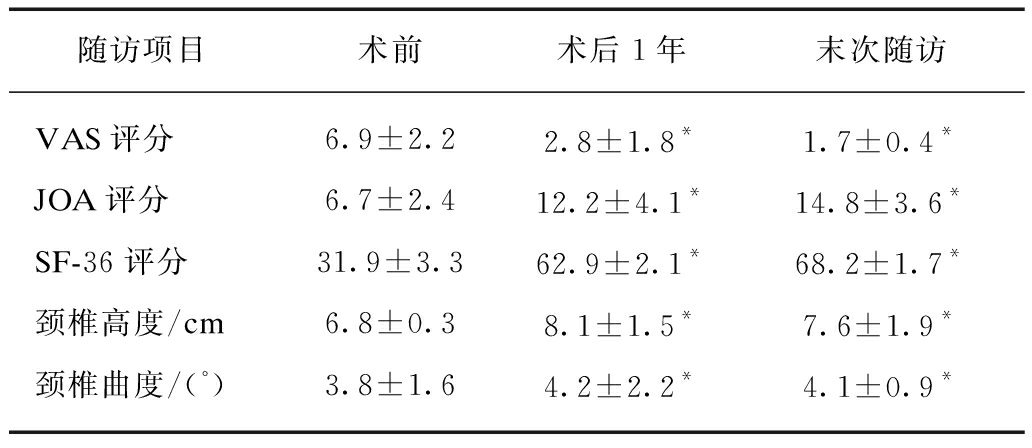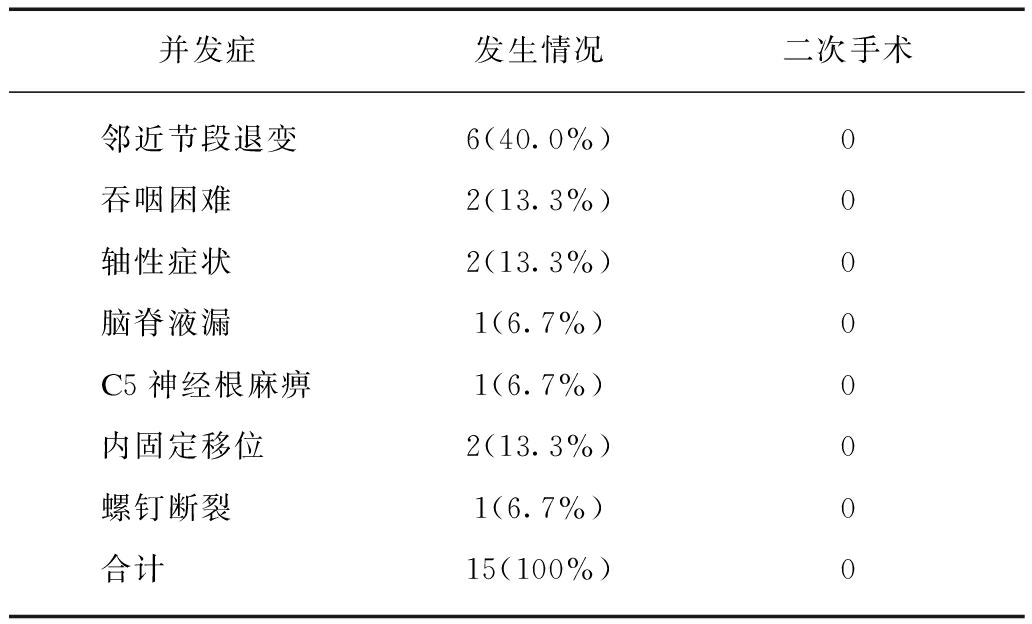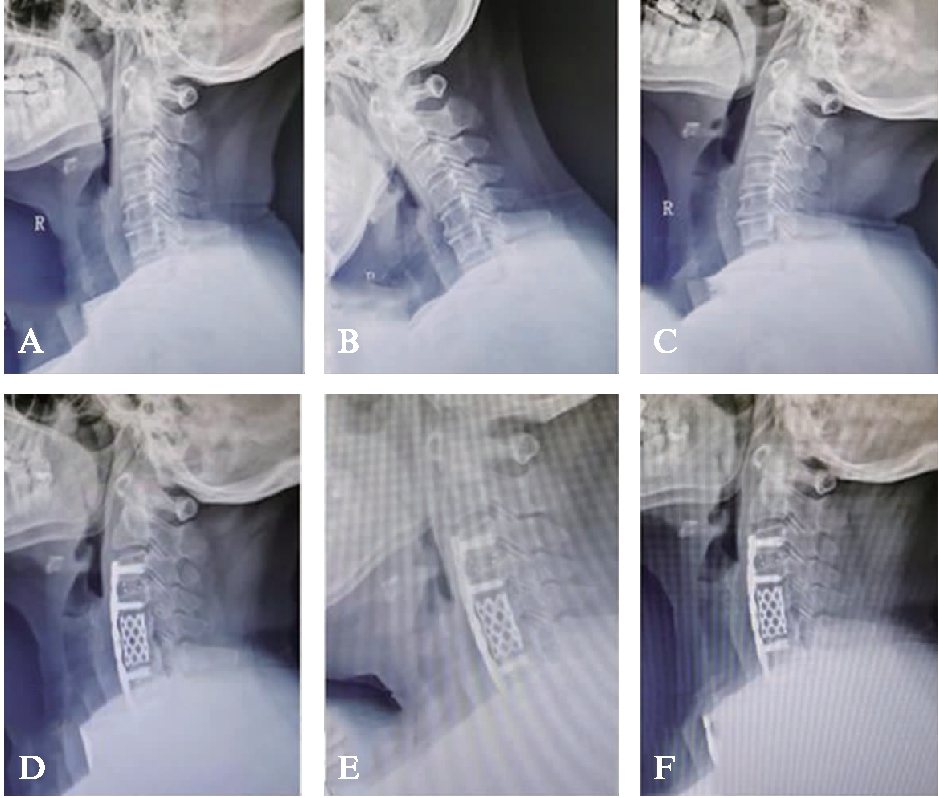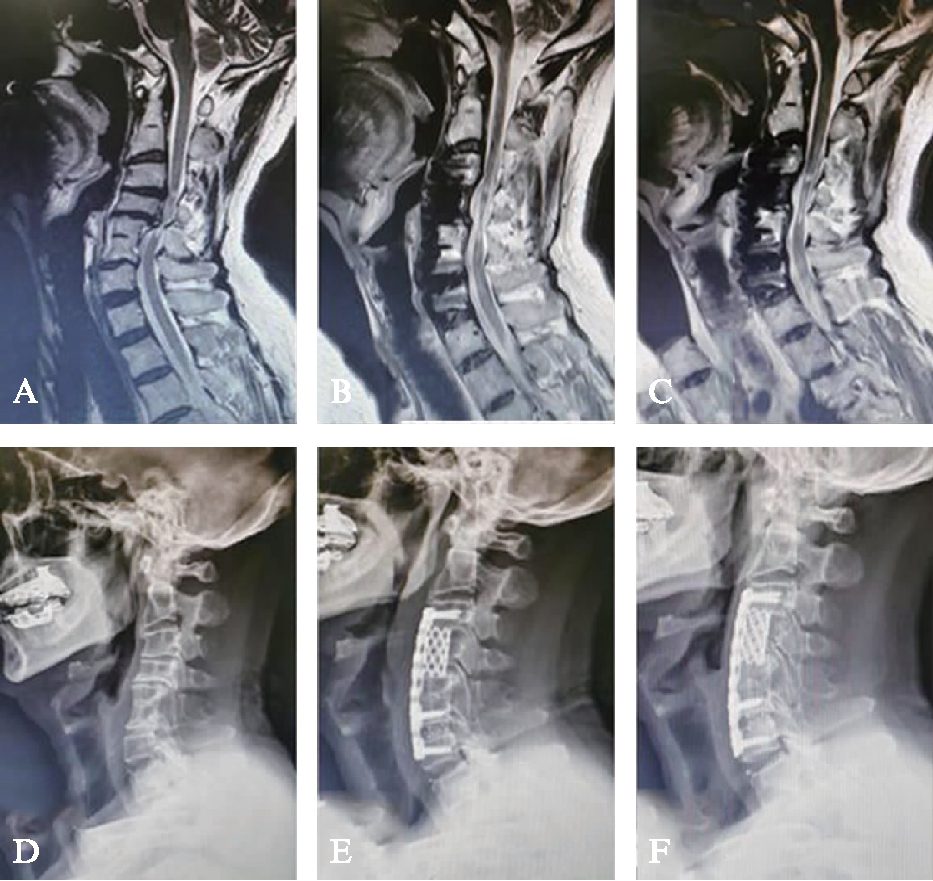多节段脊髓型颈椎病指累及3个或3个以上节段的脊髓型颈椎病,约占整个颈椎病的9%[1-2]。多节段脊髓型颈椎病常合并颈椎生理曲度变直、颈椎节段性不稳,严重者常合并颈椎后凸畸形等,多种病变相互叠加,导致病情复杂[3]。对于多节段脊髓型颈椎病的手术治疗,其手术方式颇具争议[4-6]。颈前路手术可直接解除脊髓前方压迫,是治疗脊髓型颈椎病最直接有效的治疗方式[7]。颈前路椎间盘切除植骨融合术(anterior cervical discectomy and fusion, ACDF)术野局限,对椎体后缘骨赘难以达到彻底减压;而颈前路椎体次全切植骨融合术(anterior cervical corpectomy and fusion, ACCF)则存在对颈椎破坏大、内固定稳定性低等缺点[1,8]。因此,本研究提出将ACCF与ACDF联合使用,即颈前路混合减压融合术(ACCF+ACDF)治疗3节段及以上脊髓型颈椎病,并进行了平均4年的随访,患者临床疗效满意,现报告如下。
1 资料与方法
1.1 一般资料
本研究选取2013年9月—2017年10月,在同济大学附属第十人民医院采用颈前路混合减压融合术(ACCF+ACDF)治疗多节段脊髓型颈椎病的36例患者资料,其中男21例,女15例;年龄43~71岁,平均(52.8±2.7)岁。3节段患者24例,4节段患者12例,所有患者均存在颈脊髓受压临床表现,主要包括四肢感觉、运动障碍,其中以运动障碍为主,胸腹部束带感、双手精细活动差、Hoffmann征阳性及行走不稳等。
纳入标准: (1) 患者影像学表现与临床症状相符合,诊断为脊髓型颈椎病;(2) 颈椎MRI示患者均为累及3个或3个以上节段颈椎病变;(3) 颈椎MRI示受累节段以脊髓前方压迫为主,经保守治疗无效者;(4) 病例、影像学及随访资料完整者。排除标准: (1) 涉及颈椎后路手术治疗的患者;(2) 颈椎肿瘤、感染;(3) 颈椎外伤;(4) 严重骨质疏松症患者;(5) 随访资料不全者。
1.2 手术方法
本研究手术均由同一位主任医师主刀完成。均行气管插管全身麻醉,患者取仰卧位,垫肩部保持颈椎轻度后伸,术野常规消毒铺巾。取颈前路右侧横切口,依次切开皮肤、浅层筋膜、颈横肌,于颈动脉鞘与内脏鞘之间钝性分离,直至椎前筋膜,显露椎体前方。C形臂X线机透视定位准确后,按术前计划行颈前路混合减压融合术即ACCF+ACDF。撑开器适度撑开,咬骨钳与髓核钳联合使用,次全切除椎体及上下两个椎间盘,逐步切除椎体及椎体后缘骨赘物,切断后纵韧带,见硬膜搏动良好,再次沿椎体后壁潜行刮除椎体后缘,确保减压充分,取长度合适填满骨粒的钛网进行植骨,然后再行椎间盘切除植骨融合,长节段钢板螺钉内固定。检查切口内无活动性出血,逐层进行严格止血,放置负压引流1根,缝合切口。
1.3 术后处理和随访
患者术后常规给予脱水消肿、营养神经、抗生素预防感染等治疗。术后2~3d行流质饮食,然后逐步过渡至普通饮食,术后24h拔除引流管,术后第3天在颈托保护下下地活动,术后1周拆除缝线。颈托持续保护3个月。术后1周、1年、4年进行随访,随访时间截至2019年8月。随访方式均为门诊随访。
1.4 评价指标
1.4.1 临床评估指标 (1) 用疼痛视觉模拟评分(VAS)评估患者疼痛程度。(2) 采用日本骨科协会(JOA)评分系统评估患者神经功能改善情况。JOA评分项目包括运动功能、感觉及膀胱功能,得分为0~17分。(3) 采用生活质量评价量表(SF-36)评分整体评价手术疗效。
1.4.2 影像学评估指标 (1) 在颈椎侧位X线片上测量颈椎椎体高度、颈椎曲度。颈椎椎体高度为C2~C7中点连线之间距离。颈椎曲度为C2~C7节段Cobb角,即C7椎体下缘切线与C2下缘连线的垂线上方交角。(2) 植骨融合评价: 在颈椎X线片上评价融合情况: 植骨间见有连续的骨小梁通过,过伸过屈位X线片相邻两个棘突运动<1mm即为融合。
1.4.3 并发症评价 根据患者病史采集结果及随访结果记录患者围手术期及至末次随访时发生的所有手术相关并发症,主要包括脑脊液漏、喉返神经损伤、吞咽困难、C5神经根麻痹、邻近节段退变及内固定相关性并发症。
影像学数据测量由2名脊柱外科医生分别独立进行,在评定植骨融合情况如意见不同,由上级医师参与讨论后决定。
1.5 统计学方法
采用SPSS 17.0统计学软件对数据进行统计学分析。符合正态分布数据以![]() 表示,根据正态性检验及方差齐性检验的结果,采用配对样本t检验或者Wilcoxon检验。P<0.05为差异有统计学意义。
表示,根据正态性检验及方差齐性检验的结果,采用配对样本t检验或者Wilcoxon检验。P<0.05为差异有统计学意义。
2 结 果
2.1 一般情况
34例患者获得随访,其中男19例,女15例;平均年龄(52.8±2.7)岁。随访时间为36~72个月,平均随访时间为(50.8±4.1)个月。3节段患者24例,4节段患者10例。术中出血约30~150mL,平均为(40.5±25.2) mL,手术时间90~200min,平均(110.8±29.3) min;术后住院5~7d,术后1周手术切口均一期愈合。
2.2 临床疗效结果
2.2.1 VAS疼痛评估结果 本组患者术前均存在不同程度的颈肩肢体疼痛,术前VAS评分为(6.9±2.2)分,术后颈肩肢体疼痛症状较术前均明显缓解,患者术后1年时VAS评分为(2.8±1.8)分,至末次随访时VAS评分为(1.7±0.4)分,差异有统计学意义(P<0.001),见表1。
2.2.2 JOA神经功能评分结果 所有患者术前均有不同程度的脊髓受压表现,术前JOA评分为(6.7±2.4)分,术后及末次随访均提示神经功能较前均有所恢复,术后1年时JOA评分为(12.2±4.1)分,末次随访时JOA评分为(14.8±3.6)分。术后1年、末次随访时JOA评分较术前均有明显改善,差异有统计学意义(P<0.001),见表1。所有患者术后神经功能较术前均有明显改善。末次随访Frankel分级,术前C级9例恢复至D级5例、E级4例,D级20例均恢复至E级。
2.2.3 生活质量评价量表SF-36评分结果 采用生活质量评价量表(SF-36)评分整体评价患者手术疗效,术前SF-36评分为(31.9±3.3)分,术后患者生活质量较术前均明显改善,患者术后1年时SF-36评分为(62.9±2.1)分,至末次随访时SF-36评分为(68.2±1.7)分,差异有统计学意义(P<0.001),见表1。
2.3 影像学结果
至末次随访复查颈椎正侧位及过伸过屈位X线示,2例患者出现内固定松动、移位,融合率为94.1%。术后1年及末次随访时,患者颈椎椎体高度、颈椎曲度较术前均有明显改善,差异有统计学意义(P<0.001)。末次随访时椎体高度、颈椎曲度与术后1年时比较,均有不同程度的丢失,但差异无统计学意义(P>0.05),见表1。
2.4 并发症情况
34例患者中有11例患者出现15例次并发症,并发症发生率为44.1%。本组病例未见切口感染、颈前血肿、食道瘘等严重并发症。本组患者并发症发生情况见表2,有6例患者发生邻近节段退变,但患者无明显临床症状和主诉,予随访观察。2例患者术后出现一过性吞咽困难,给予雾化吸入等治疗后,患者症状在术后1个月均得到缓解。2例患者出现轴性症状,应用消炎止痛药后1个月内缓解。1例患者术后出现脑脊液漏,给予保持仰卧位、加强换药、加强抗生素防治感染等处理,患者均获得痊愈。1例患者术后出现C5神经根麻痹表现,给予营养神经、口服塞来昔布(西乐葆),患者在术后2个月内症状改善。2例患者出现内固定移位,1例患者出现螺钉断裂,该3例患者均无特殊不适主诉,无相关临床症状,继续给予随访观察。
表1 术前、术后1年、末次随访结果比较
Tab.1 Comparison of preoperative, 1 year postoperative and last follow-up outcome

随访项目术前术后1年末次随访VAS评分6.9±2.22.8±1.8*1.7±0.4*JOA评分6.7±2.412.2±4.1*14.8±3.6*SF-36评分31.9±3.362.9±2.1*68.2±1.7*颈椎高度/cm6.8±0.38.1±1.5*7.6±1.9*颈椎曲度/(°)3.8±1.64.2±2.2*4.1±0.9*
与同组术前比较,*P<0.001
表2 手术并发症及再次手术情况
Tab.2 Complications of operation and reoperation

并发症发生情况二次手术邻近节段退变6(40.0%)0吞咽困难2(13.3%)0轴性症状2(13.3%)0脑脊液漏1(6.7%)0C5神经根麻痹1(6.7%)0内固定移位2(13.3%)0螺钉断裂1(6.7%)0合计15(100%)0

图1 多节段脊髓型颈椎病典型病例1
Fig.1 Case 1 of multilevel cervical spondylotic myelopathy
典型病例1,男性患者,55岁;A: 术前颈椎侧位X线示颈椎生理曲度变直,C4~C6椎体前方骨赘形成;B~C: 术前颈椎动力位X线示颈椎不稳;D: 术后4年X线片示内固定位置良好,颈椎生理曲度恢复;E~F: 术后4年X线示植骨达骨性融合,内固定位置良好,无松动、移位

图2 多节段脊髓型颈椎病典型病例2
Fig.2 Case 2 of multilevel cervical spondylotic myelopathy
典型病例2,男性患者,64岁;A: 术前颈椎MRI T2W1示C3/4、C4/5、C6/7椎间盘退变突出,脊髓前方受压;B~C: 术后颈椎MRl T2WI示术后脊髓前方压迫解除;D: 术前X线片示颈椎后凸畸形,多个椎体前方骨赘形成;E: 术后1年X线片示颈椎生理曲度恢复,内固定位置良好;F: 术后4年X线示植骨达骨性融合,内固定位置良好,无松动、移位
3 讨 论
多节段脊髓型颈椎病是危害性最大的一类脊髓型颈椎病,具有病变范围大、患者症状重,且常合并后纵韧带骨化、颈椎生理曲度消失等特点[9-11]。其手术目的旨在彻底解除病变节段对脊髓的压迫,防止病情进一步恶化[8-9]。彻底减压、维持脊柱稳定性和恢复颈椎生理曲度是手术治疗的基本原则[12-13]。本研究将ACCF与ACDF结合使用,即颈前路混合减压融合术(ACCF+ACDF)治疗多节段脊髓型颈椎病,并对患者进行了平均4年的随访,以探讨该术式的中期疗效及其并发症情况。
文献报道,颈前路减压融合手术治疗多节段脊髓型颈椎病,尽管减压、融合的方式不同,但患者的神经功能均得到显著改善,获得良好的临床疗效[14-16]。在本组病例中,36例患者颈肩肢体疼痛较术前得到明显缓解,其神经功能评分也显著提高。本研究结果表明,至末次随访时,患者VAS疼痛评分、JOA神经功能评分和生活质量评价量表SF-36评分均较术前明显改善,患者获得了满意的中期临床疗效,这与很多文献研究结果一致[17-18]。
多节段脊髓型颈椎病常合并颈椎生理曲度消失,严重者常常合并后凸畸形,其手术治疗方式并不是单节段术式的单纯叠加,更需考虑到颈椎生理曲度、固定稳定性[11,19]。连续两个椎体次全切除植骨钢板固定手术,严重破坏了颈椎稳定性,且钢板力臂较长,钢板两端应力较大,容易导致内固定松动、移位等并发症[6]。本研究结果表明,采用颈前路混合减压融合术,2例患者内固定轻度移位,但患者均无特殊不适主诉,无相关临床症状,均给予随访观察。至末次随访,患者颈椎高度及生理曲度与术前相比较均有明显的改善。本研究表明,采用颈前路混合减压融合术(ACCF+ACDF),减少了脊柱破坏,缩短了钛网植骨长度,使脊柱稳定性较好,且能有效恢复颈椎生理曲度及颈椎高度[1,8]。
有研究报道颈前路减压钛网固定术后钛网沉陷可导致颈椎后凸畸形,发生率为16%[17,20]。钛网沉陷还可导致内固定失败,患者神经症状复发,部分患者需要再次手术。研究表明,钛网的长度与术后发生沉陷的概率呈正比[9]。长节段椎体次全切使用长钛网植骨,长钛网两端应力较大,容易发生钛网塌陷、移位。此外,长节段椎体切除手术只有两个植骨块-椎体接触面,稳定程度较差,不利于骨性融合。研究报道两节段椎体次全切植骨内固定的融合率为91%,单椎体次全切植骨内固定联合分节段单间隙减压的融合率为100%[21]。本研究认为,采用颈前路混合减压融合术,钛网长度较短,沉陷的发生率较低。本组病例仅2例患者出现内固定松动、轻度移位,融合率为94.1%,与文献报道基本一致[3,22]。
本组病例有6例患者出现邻近节段退变,发生率为17.6%,高于既往文献报道[23-24],可能主要由以下几个因素造成。(1) 本研究患者均为≥3节段脊髓型颈椎病,患者病变范围广,手术造成了较多节段活动度丧失,完全改变了原有应力分布,从而使得邻近节段加速退变。(2) 研究表明,颈椎前路钢板边缘距离邻近节段小于5mm是邻近节段退变明确的危险因素[25],由于患者均为多节段病变,长钢板放置时往往难以控制钢板长度,本研究中钢板与邻近间隙的距离小于 5mm。因此,术中钢板位置不佳可造成邻近节段退变性。本组6例患者均无明显临床症状、体征,均是随访复查X线片时才发现,均予继续随访观察。
综上所述,颈前路混合减压融合术即ACCF+ACDF的个性化组合手术方式,在保证术中彻底减压的基础上,尽可能保留颈椎结构,保证了颈椎的稳定性,能够恢复并长时间维持颈椎生理曲度及颈椎高度,减少了术后植骨不融合及内固定失效等并发症的发生,是治疗多节段脊髓型颈椎病行之有效的手术方式。
[1] ZHAO C M, CHEN Q, ZHANG Y, et al. Anterior cervical discectomy and fusion versus hybrid surgery in multilevel cervical spondylotic myelopathy: a meta-analysis[J]. Medicine(Baltimore), 2018,97(34): e11973.
[2] ZHANG J X, LIU H, BOU E H, et al. Comparative study between anterior cervical discectomy and fusion with ROI-C cage and laminoplasty for multilevel cervical spondylotic myelopathy without spinal stenosis[J]. World Neurosurg, 2019,121: e917-e924.
[3] CHEN H, LIU H, MENG Y, et al. Short-term outcomes of anterior fusion-nonfusion hybrid surgery versus posterior cervical laminoplasty in the treatment of multilevel cervical spondylotic myelopathy[J]. World Neurosurg, 2018,116: e1007-e1014.
[4] ISOGAI N, NAGOSHI N, IWANAMI A, et al. Surgical treatment of cervical spondylotic myelopathy in the elderly: outcomes in patients aged 80 years or older[J]. Spine(Phila Pa 1976), 2018,43(24): E1430-E1436.
[5] HE S H, FENG H L, LAN Z M, et al. A randomized trial comparing clinical outcomes between zero-profile and traditional multilevel anterior cervical discectomy and fusion surgery for cervical myelopathy[J]. Spine(Phila Pa 1976), 2018,43(5): E259-E266.
[6] CHEN Z H, LIU B, DONG J W, et al. A comparison of the anterior approach and the posterior approach in treating multilevel cervical myelopathy: a meta-analysis[J]. Clin Spine Surg, 2017,30(2): 65-76.
[7] BUTTERMANN G R. Anterior cervical discectomy and fusion outcomes over 10 years: a prospective study[J]. Spine(Phila Pa 1976), 2018,43(3): 207-214.
[8] LU V M, ZHANG L, SCHERMAN D B, et al. Treating multi-level cervical disc disease with hybrid surgery compared to anterior cervical discectomy and fusion: a systematic review and meta-analysis[J]. Eur Spine J, 2017,26(2): 546-557.
[9] WANG T, WANG H, LIU S, et al. Anterior cervical discectomy and fusion versus anterior cervical corpectomy and fusion in multilevel cervical spondylotic myelopathy: a meta-analysis[J]. Medicine(Baltimore), 2016,95(49): e5437.
[10] XU L P, SUN H, LI Z H, et al. Anterior cervical discectomy and fusion versus posterior laminoplasty for multilevel cervical myelopathy: a meta-analysis[J]. Int J Surg, 2017,48: 247-253.
[11] SENGUPTA D K. Functional and radiological outcome in patients undergoing a three-level corpectomy for multilevel cervical spondylotic myelopathy and ossified posterior longitudinal ligament[J]. Neurol India, 2016,64(1): 23-24.
[12] 李振环,徐广辉,禹宝庆,等.颈后路全椎板切除减压治疗颈椎脊髓损伤的临床疗效分析[J].同济大学学报(医学版),2018,39(4): 114-119.
[13] SHANGGUAN L, NING G Z, TANG Y, et al. Discover cervical disc arthroplasty versus anterior cervical discectomy and fusion in symptomatic cervical disc diseases: a meta-analysis[J]. PLoS One, 2017,12(3): e0174822.
[14] WEI L X, CAO P, XU C, et al. Clinical and radiologic results of anterior cervical discectomy and fusion for cervical spondylotic myelopathy in elderly patients with T2-weighted increased signal intensity[J]. World Neurosurg, 2018,112: e520-e526.
[15] LIOW M H L, LEE M, GOH G S, et al. Poorer fusion outcomes in diabetic cervical spondylotic myelopathy patients undergoing single-level anterior cervical discectomy and fusion does not compromise functional outcomes and quality of life[J]. Spine(Phila Pa 1976), 2018,43(7): 477-483.
[16] BAKER J F, GOMEZ J, SHENOY K, et al. A radiographic follow-up study of stand-alone-cage and graft-plate constructs for single-level anterior cervical discectomy and fusion[J]. J Spine Surg, 2017,3(4): 596-600.
[17] MA Z, MA X, YANG H L, et al. Anterior cervical discectomy and fusion versus cervical arthroplasty for the management of cervical spondylosis: a meta-analysis[J]. Eur Spine J, 2017,26(4): 998-1008.
[18] KAPETANAKIS S, THOMAIDIS T, CHARITOUDIS G, et al. Single anterior cervical discectomy and fusion(ACDF) using self-locking stand-alone polyetheretherketone(PEEK) cage: evaluation of pain and health-related quality of life[J]. J Spine Surg, 2017,3(3): 312-322.
[19] HUANG D, DU X L, LIANG H T, et al. Anterior corpectomy versus posterior laminoplasty for the treatment of multilevel cervical myelopathy: a meta-analysis[J]. Int J Surg, 2016,35: 21-27.
[20] IMAJO Y, TAGUCHI T, NEO M, et al. Surgical and general complications in 2961 Japanese patients with cervical spondylotic myelopathy: comparison of different age groups[J]. Spine Surg Relat Res, 2017,1(1): 7-13.
[21] TUMIAL N L M, PONTON R P, COOPER A N, et al. Rate of return to military active duty after single and 2-level anterior cervical discectomy and fusion: a 4-year retrospective review[J]. Neurosurgery, 2019,85(1): 96-104.
N L M, PONTON R P, COOPER A N, et al. Rate of return to military active duty after single and 2-level anterior cervical discectomy and fusion: a 4-year retrospective review[J]. Neurosurgery, 2019,85(1): 96-104.
[22] OLIVER J D, GONCALVES S, KEREZOUDIS P, et al. Comparison of outcomes for anterior cervical discectomy and fusion with and without anterior plate fixation: a systematic review and meta-analysis[J]. Spine(Phila Pa 1976), 2018,43(7): E413-E422.
[23] LAXER E B, BRIGHAM C D, DARDEN B V, et al. Adjacent segment degeneration following ProDisc-C total disc replacement(TDR) and anterior cervical discectomy and fusion(ACDF): does surgeon bias effect radiographic interpretation?[J]. Eur Spine J, 2017,26(4): 1199-1204.
[24] PESCE A, WIERZBICKI V, PICCIONE E, et al. Adjacent segment pathology: natural history or effect of anterior cervical discectomy and fusion? A 10-year follow-up radiological multicenter study using an evaluation scale of the ageing spine[J]. Eur J Orthop Surg Traumatol, 2017,27(4): 503-511.
[25] YOU J P, TANG X H, GAO W S, et al. Factors predicting adjacent segment disease after anterior cervical discectomy and fusion treating cervical spondylotic myelopathy: a retrospective study with 5-year follow-up[J]. Medicine(Baltimore), 2018,97(43): e12893.